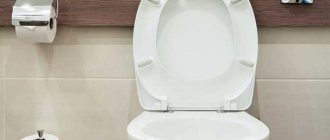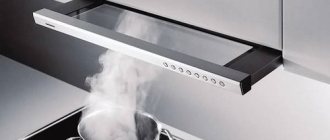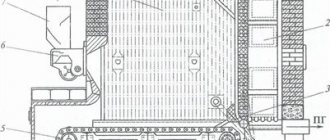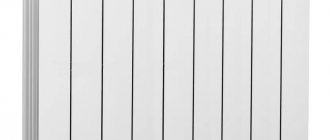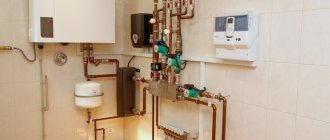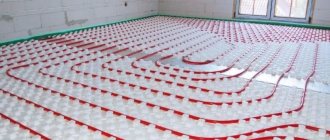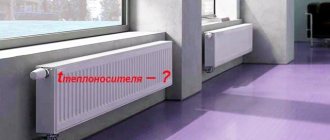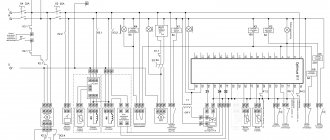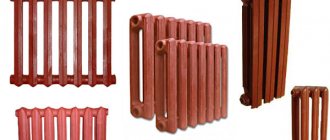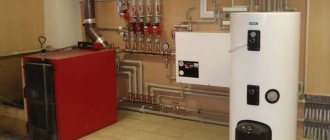In Russian winter conditions, when central heating is not enough, it is impossible to do without additional heaters. You can get by more precisely, but at what cost? Persistent colds, coughs or bronchitis. Such savings will result in large costs for restoring damaged health. But even if you understand the need to install a heater in your home, you need to choose the right model that will heat the room and consume a minimum of electricity.
How to calculate power
To calculate the power of the heater, you can use a simple formula that is offered by almost all manufacturers.
The formula is relevant for all devices except infrared radiators (we will do a separate calculation for them). Power depends on the size of the heated room, but not only on square meters - you also need to know the height of the ceilings. Let’s say the area of the room is 20 square meters, the ceilings are standard – 2.7 meters. You need to multiply 20 m2 by 2.7 m. We get the volume of the room equal to 54. Next, divide 54 by 30 (the constant coefficient that manufacturers suggest using for calculations). The radiator power must be at least 1.8 kW.
If this method is complicated, you can use a simpler method, but it is only suitable for houses with ceiling heights up to 3 meters. A minimum of 100 W is required per 1 square meter. You need to multiply the area of the room by 100 W. The answer received is the recommended power. For example, the size of the room is 15 square meters. We multiply 15 by 100, we get 1.5 kW.
However, the calculation does not take into account the nuances: the presence of cracks in windows and walls from which cold air enters, the end location of the apartment, drafts, and so on. If the listed problems are present, as well as for unheated rooms, you need to add 20-30% to the received power so that the heater works correctly and performs its functions.
For infrared devices, power is calculated differently, since they have a high energy consumption class. In order for the device to work as efficiently as possible, not only the square footage of the house is taken into account, but also the number of people and objects in the room. On average, heating 1 square meter requires 50 W, which is 2 times less than for other models.
How do manufacturers ensure safety?
Safety is one of the main criteria when choosing a radiator.
The appliance must support automatic shutdown when overheated, tilted or tipped over. This will allow you to leave the device on even if you are not at home. The overheat shutdown option is provided by a temperature sensor. When the heating element reaches the maximum temperature, the temperature sensor breaks the connection in the electrical circuit, which leads to shutdown.
It is desirable that the heater can support the antifreeze function when the air temperature in the room does not fall below 5-7 degrees. Of course, these are uncomfortable conditions for a person. However, for rooms with water supply and sewerage when the heating is turned off, this temperature will be enough to prevent the pipes from freezing.
If you choose a device for heating a bathroom, bathhouse or other rooms with high levels of humidity, choose a model with a waterproof housing. Otherwise, short circuits cannot be avoided, which can lead to device failure and fire.
Which control to choose
For most people, the type of control of the heating device is not important until they learn about the possibilities of electronic control. Let's look at them:
- Accurate temperature setting in 1 degree increments. In mechanical control you can set the temperature from 5-30 degrees.
- Timer. You can set a specific time to turn the device on and off. For example, before coming home, turn on the device 30-60 minutes before your return home will be warm.
- Remote control. Modern models use special programs to transmit data via Wi-Fi and Bluetooth to a mobile phone. From your phone you can turn the heater on or off, set the temperature, program the timer, and so on.
Mechanically controlled radiators do not have these capabilities.
Product range overview
Heating devices include:
- heat guns;
- convectors;
- oil and convection radiators;
- infrared heaters;
- thermal curtains.
The listed equipment is selected for specific purposes, taking into account the capabilities and need for maintenance. If the performance of the device does not meet the needs of the room, it will waste energy. Thermal curtains are not used in everyday life. They are relevant in shops, large workshops and industrial facilities. The rest can be found at home, in the country or in the garage. It is for them that the relevant question is how to calculate the power of the heater.
Verification of calculations by experience.
As you might guess, such a somewhat strange example was not chosen by chance, but to allow for a simple experiment and subsequent comparison of the results. A thermometer and a watch were taken and the temperature of the water in the jar was measured during the heating process. The results of calculations and experiments are reflected in the graphs.
The results of the experiment showed that heating a jar of water from +13 °C to +22 °C in a room (+24 °C) lasted approximately 3 hours 20 minutes. This is 5 minutes less than the estimated time according to Kondratiev and 17 minutes longer than the time according to the classical Newton-Richmann law.
The similarity of the results is both pleasing and surprising. But do not overestimate the results obtained! The cooling (heating) time calculated using the proposed calculation program in Excel can only be used for rough estimates of the duration of processes! The fact is that the thermophysical characteristics of the body and the heat transfer coefficient accepted in the calculation as constants are not actually such. They depend on changing temperatures! In addition, a regular heat exchange regime is not established immediately after placing the body in the environment, but after some time.
Please note that the experimentally obtained temperatures of a jar of water during the first hour are located above the theoretical design curve (see graphs). This means that the heat transfer coefficient in this period of time was greater than our chosen value α = 8.3 W/(m2 K).
Let us determine the average value of α in the first 58 minutes from the experimental results. For this:
- Let's write t2=17.5 °C in cell D6.
- We activate (“stand with the mouse”) cell D28.
- Let's do: Service – Parameter selection.
- And set D28 to 58 minutes by changing cell D3.
α =9.2 W/(m2 K)!!!
Having done the same procedure for t2 = 22.5 °C and t = 240 min, we obtain α = 8.3 W/(m2 K).
α chosen during the theoretical calculation (according to the recommendation of SP 50.13330.2012 and the formula from the Handbook of Physics - see note to cell D3) miraculously, although completely by accident, coincided with the value of α calculated from experimental data.
Using the considered method, it is possible to determine the real accurate average values of the heat transfer coefficient of bodies with any surface shape from practical measurements of just two values of body temperature and the time interval between these measurements.
It remains to add that the temperature of the jar of water after the considered 4 hours will subsequently asymptotically approach 24 °C.
I ask those who respect the author’s work to download the file with the calculation program after subscribing to article announcements!
Link to download the file: vremya-ohlazhdeniya (xls 55.5KB).
Quick calculation of performance for a heated room
This option is very simple, but does not allow you to calculate the power of the infrared heater. Required:
1. Measure the area (s).
2. Determine the height of the walls (h).
3. Calculate the volume of the room (v) by multiplying the first values.
4. Divide the result of calculating cubic capacity by 30 - a specially defined coefficient number for this type of calculation.
The formula for the determined productivity looks like this: W=s*h/30.
For example: room area - 18 square meters. m, the height of its walls is 2.8 m. We get a cubic capacity of 50.4 cubic meters. m. We divide the volume by 30 and see the result - 1.68 kW is needed to heat the room and keep it warm. In general, we can say that for 10 sq. m (height up to 3 m) you need up to 1 kW/h.
This method will be more accurate if you take into account the location of the rooms in the building. For an office in the northern or corner part, we increase the predicted productivity to 20%.
Calculation of cooling (heating) time in Excel.
The calculation algorithm is based on the Newton-Richmann law and on theoretical and practical studies of the regular thermal regime by Soviet scientists G.M. Kondratyev (“Regular thermal regime”, Moscow, 1954) and M.A. Mikheev (“Fundamentals of Heat Transfer”, Moscow, 1977).
For example, we chose to calculate the heating time to +22 °C in a room with an air temperature of +24 °C of an aluminum beer can with water pre-cooled to +13 °C.
Initial data:
The parameters required to calculate the cooling (heating) time are 12 (see screenshot).
Approximate information about the values of the heat transfer coefficient α is given in the note to cell D3.
The thermophysical characteristics of the body material λ , a , ρ , c can be easily found in reference books or upon request on the Internet. In our example, these are water parameters.
In principle, to perform the calculation it is enough to know the values of any of the pairs of characteristics: λ , a or ρ , c . But to be able to perform the check and minimize the likelihood of an error, I recommend filling in all 4 cells with values.
We enter the values of the initial data into the corresponding cells of the Excel sheet and read the result: heating water from +13 °C to +22 °C in the calm air of a room with a constant temperature of +24 °C will last 3 hours 25 minutes.
For reference, at the very end of the table, the heating time is calculated without taking into account the shape of the body - 3 hours 3 minutes.
Calculation algorithm:
- 13.1. F =2 · H · L +2 · B · L +2 · H · B – for a parallelepiped;
- 13.2. F =π · D · L +2 · π · D 2 /4 – for a cylinder;
- 13.3. F = π · D 2 – for the ball.
- 14.1. V = H · L · B – for a parallelepiped;
- 14.2. V = L · π · D 2 /4 – for a cylinder;
- 14.3. V = π · D 3 /6 – for the ball.
- 15. G = ρ V _
- 16.1 K =(( π / H )2 + ( π / L )2 + ( π / B )2)-1 – for a parallelepiped;
- 16.2 K =((2.405 /( D /2))2 + ( π / L )2)-1 – for the cylinder;
- 16.3 K =( ( D /2)/ π )2 – for the ball.
- 17. m ∞ = a / K
- 18. Bi = α K F / ( λ V ) _ _
- 19. Ψ=(1+1.44 Bi + Bi 2 ) -0.5
- 20. M= Ψ Bi
- 21. m αλ = M m ∞ _
- 22. m cρ = Ψ α F / ( c ρ V ) _ _ _
- 23. Δ = ABS (1-m αλ / m cρ ) 100
- 24. t =(LN (ABS (tc-t1)) -LN (ABS (tc-t2))/m αλ
- 25. t N =(LN (ABS (tc-t1)) -LN (ABS (tc-t2))) c ρ V /( α F)
How to calculate the power of electric heaters for a garage or warehouse
This algorithm is suitable for unheated utility rooms. It takes into account volume, thermal insulation of walls, temperature differences.
1. Determine the cubic capacity of the room: v=s*h.
2. Calculate the temperature difference (? T). We subtract the street readings from the expected temperature.
3. We multiply the resulting numbers together with the thermal insulation coefficient (k) and get the required number of kilocalories per hour needed for heating and maintaining heat.
4. Divide everything by 860. The result will be the required kilowatts.
The formula that allows you to calculate the power of electric heaters for garages and other utility rooms: W=k*v*?T/860.
The thermal insulation coefficient is different:
- structures without thermal insulation – 4.0;
- simple buildings made of wood or corrugated board - from 3.0;
- single brickwork with a simple window and roof structure - from 2.0;
- ordinary buildings (Soviet multi-storey buildings, old buildings) – from 1.0;
- modern buildings or with additional insulation - from 0.6.
As an example, we suggest calculating the predicted power of electric heaters for a garage with single brick masonry and a simple slate roof. Let's say its area is 24 square meters. m, from floor to ceiling - 3 m, outside temperature - -3 degrees, we want to get heat +15. We calculate using the formula:
W=2*24*3*(15 - (-3)/860=3 kW, or W=2.9*24*3*(15 - (-3)/860=4.4 kW.
Conclusion: for heating under the specified conditions, a performance of 3 to 4.4 kilowatts is required.
We are starting a short series of articles devoted to calculating the power of heaters for apartments and private houses. Let's start with heating radiators. Why is it important? The answer is simple: the house should be warm and comfortable. Even in the most severe frosts, you don’t wear felt boots and a hat indoors. And ideally, never buy electric heaters. On the other hand, heat is also not an option. Forcibly turning off radiators will not help save on utility bills, and regular ventilation of rooms is not always possible. Especially if there are children in the house.
Therefore, let's find out how many radiator sections are needed for a comfortable life. And how to get this figure.
The simplest calculation
If you are building a house yourself and are not very versed in heating issues, you will easily fall for the bait of construction store consultants. Very often you can hear that the calculation of radiator sections is the most basic:
100 W of power per 1 square meter
Or another option:
2 battery sections per 1 square meter
It would seem that everything is clear and understandable. But it's all about the nuances. Such a primitive formula does not take into account the features of the room, the height of the ceilings, the number of doors and windows, the presence of thermal insulation and balconies. Everything that affects heat loss and without which the heating system will not work efficiently and - what is important - economically.
What information is needed
Before you start calculating the heater’s power, collect a “history”.
This is all the information about the specific room where it is planned to install heating devices.
- Climate of the area and air temperature during the heating season. The choice of heaters, calculation of their quantity and power will be very different in the middle zone and northern part of our country.
- Location of the room and specifically the windows (north, south, east, west)
- Purpose of the room: living room, children's room, kitchen, utility room, attic.
- Wall material and thickness.
- The number of windows, doors, their configuration (regular or French windows), the presence and type of balconies (loggia, attic).
- Ventilation - natural and forced.
Then you need to decide on the material of future radiators. Usually this happens at the stage of the design project, but if we are talking about an apartment with already installed appliances, and you want to change them, the decision to replace them is made at the first stages of the renovation. The number of radiator sections per room depends on their type:
- Steel ones have a power of 100-150 W per section
- Cast iron - 160 W
- Bimetallic - 170-180 W
- Aluminum - the most powerful, 180-200 W.
And one more parameter. The above power values for radiators of different materials are ideal. The manufacturer indicates them in the accompanying documentation, but they are slightly divorced from reality. The power of the heating radiator section is affected by the coolant temperature. If you know it, the calculation will be more accurate. The so-called DT parameter takes into account the temperature of the coolant at the inlet and outlet. The maximum power of the radiator section is achieved with the 90/70 parameter. But such temperatures are rare for the Russian heating system. The standard figure is 67-75/53-55 °C.
Calculation by area
This is the same simple calculation that we talked about above, but with clarifications. Suitable for rooms with normal ceiling heights, no more than 3 meters.
Formula:
100 W*S/N,
where S is the area of the room (m²) and N is the power of the radiator section
Example:
100*15/150=10
10 radiator sections will be needed to heat a 15-meter living room.
To get a more realistic and accurate figure add:
- +20% for a balcony in the room or a bay window;
- +30% for two windows, two external walls and a corner location of the apartment;
- +10-15% for screens for radiators that completely hide them;
- + 15% is always added in case of abnormal cold weather.
The calculation formula is also clarified by the climate coefficient. It is relevant for the northern and southern regions, where the air temperature differs significantly from central Russia. The coefficient for the north is 1.6. For the south - 0.9.
Calculation by room volume
It is carried out for rooms with high ceilings and non-standard configurations. It is based on the fact that heating 1 cubic meter of room requires 40 W of thermal power.
Formula:
V*40W/N,
Where V is the volume of the room m3, and N is the power of the radiator section
Calculation example:
104 (width 6.5*length 5*height 3.2)*40/150 = 27.
Those. 27 sections will be needed for comfortable heating of a room with a volume of 104 m3.
Detailed calculation of the number of heating radiator sections
This formula has a lot of clarifications. It may be suitable for apartments, but for this you need to know all the intricacies of building a specific multi-story building. Nevertheless, the owner of the cottage has the privilege to directly participate in the construction of the facility, control the purchase of building materials and finishing, and also receive comprehensive information about each material used.
Formula
100W *S *K1 *K2 *K3 *K4 *K5 *K6 * K7,
where S is the area of the room (m²), and the set K is coefficients that will help detail the calculation.
K1 - window glazing: coefficient for double glazing, 1.0 for double glazing, 0.85 for triple glazing.
K2 - coefficient of thermal insulation of walls: 1.27 low, 1.0 single-layer, 0.85 two-layer.
K3 - window to floor area ratio: 0.8 (10%); 0.9; 1.0; 1.1; 1.2 (50%).
K4 - coefficient of the lowest temperature in winter: 0.7 (10°C); 0.9 (15°C); 1.1 (20°C); 1.3 (25°C); 1.5 (30°C).
K5 - coefficient of the number of external walls: one 1.1; two 1.2; three 1.3; four 1.4.
K6 - room type: attic coefficient 1; warm attic - 0.9; warm ground floor - 0.8
K7 - ceiling height: coefficient 1 for a height of 2.5 meters; 1.05 for 3 m; 1.1 for 3.5 m; 1.15 for 4 m; 1.2 for 4.5 m.
The following will help you save on the number of radiator sections without losing heat:
- High-quality thermal insulation
- Insulation of doors and slopes
- Glazed and insulated loggias and balconies
- Heating appliances operating in the kitchen or dining area: stoves, ovens, grills, etc. This is why it is so important to consider the type of room for installing and calculating radiators.
Infrared heaters: how to calculate their power?
Such a device heats objects and people, their heat further spreads throughout the room. Therefore, the required performance is determined differently. You can calculate the power of an infrared heater in space as follows: depending on the model, per 1 sq. m, costs of up to 0.1 kilowatt are expected. This number can start from 0.01 kW.
Pay attention to the factory specifications to understand how to calculate the heater's power. Modern infrared heat producers provide significant savings in unheated rooms. But their efficiency is on average 2 times less. That is, per 1 sq. m costs can reach 0.2 kilowatts.
Automatic thermoregulation
Previously, home owners simply had no choice but to calculate all the numbers and monitor heat loss in the house, the power of heaters, etc. However, these days, you can greatly simplify your task thanks to a modern device - a thermostat that operates on the basis of heat sensors.
Automatic thermoregulation is carried out using a special device
Of course, all innovations concern only autonomous heating, which has a serious advantage over central heating. For example, if you want the room temperature to be 22 degrees, then you need to be truly a genius to calculate all the heat loss using the formula and guess which radiators to put in the rooms. However, if you have temperature sensors, everything is simple - you set the desired temperature, and the boiler itself heats the batteries as much as necessary. The sensor will show when the boiler should stop, and vice versa will inform the device when the temperature has dropped below again and the room needs to be heated. If you want to accurately and conveniently control the level of heat in your home, then we advise you to use autonomous heating and not complicate your life with complex calculations.
Some tips for choosing
Each manufacturer is now trying to provide the buyer with a full set of equipment that he may need, power is also taken into account. The electric boiler was no exception. It comes complete with a programmer, a pump for coolant circulation, and an expansion tank. Thanks to this, it is easy to understand what the power indicator of an electric boiler should be. Even a novice user can handle this.
In addition, devices to protect equipment and special cables are required. Thus, the installation can be completely done by yourself. The power of the boiler does not matter.
But sometimes independent additional equipment is required. For those who understand electric models, this solution is often the most relevant. Including power. The power supply system can be used of the usual type if an electric boiler is installed, the power of which reaches 6 kW.
Recently, the electricity consumption of an electric boiler has become no less important an indicator than the installation of a special pump in the system. This solution also helps to understand how much electricity is being wasted and why. In this case, consumption is noticeably reduced. The system will be able to use pipes with a smaller diameter than in a normal situation. A wet rotor pump is the main type of equipment that can most often be seen in private homes. Its power fully meets the requirements.
- The rotor is washed with liquid, which is never pumped by electrical equipment. Resource consumption becomes more profitable.
- No additional fan is required because the device never overheats. The boiler's power is sufficient for normal loads.
- Due to the fact that there is no fan, the operation of the entire system becomes almost silent. In residential premises this becomes especially relevant; power does not suffer from this.
Such pumps themselves can support automatic or manual adjustment. Power in this case does not play a big role. The first option is the most preferable because it saves energy. Then heating with an electric boiler itself becomes more profitable.
How much does his work cost? To make a calculation, it is enough to know about some operating features. For example, what temperature is most often maintained in the room. As for the general scheme for heating a house, it is better to choose forced circulation. This is also the best option, allowing you to achieve maximum results with minimal investment.
